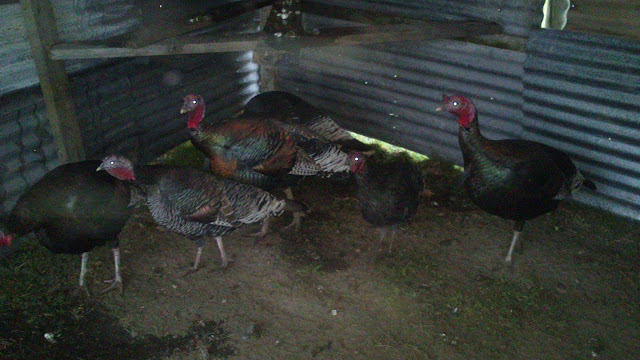Every year several of my hens go broody. Every year I get excited and watch for signs
of chicks. Until now, every year I’ve
been disappointed. I’ve heard so many
theories about why it never happened.
Howard, our first rooster was a bantam, he arrived with
his mother Mrs Wolowitz. I called him
Howard after The Big Bang Theory character because of the way he’d sidle up to
my hens (who generally were bigger than him), do a little dance and try to jump
on. He didn’t give up even when they
wouldn’t have a bar of him, he’d puff himself up until he nearly exploded and
keep on trying.
The dog killed him.
I’ve since trained the dog to leave the chooks alone, he was still a
puppy at that stage and would chase anything that ran.
Then I bought Captain Jack. A big beautiful Australorp rooster. I still got no chicks, but only Mrs Wolowitz,
my little bantam hen, ever got broody and she’d change which nesting box she
was sitting in every couple of days, so there was never any chance of eggs hatching. I got a few more hens and was given Midnight
- another big beautiful Australorp rooster.
Midnight and Captain Jack didn’t get along. I spent several hours cleaning up the blood
and cleaning Midnight’s wounds.
Captain Jack died, not sure what from, so Midnight became
cock of the walk. By then though, he was servicing 50 hens. I was told that he had too many hens and that the ratio should be somewhere between one rooster to 6 hens up to one rooster to 10 hens (depending on who you talk to). Dad said to look at the condition of my rooster, if I had too many hens, he'd be in poor condition and thoroughly hen-pecked (the origin of the term is a literal thing). He was always fully feathered and looking fantastic, all showy and glossy and proud.
 |
| Midnight after the fight |
Last summer, one of my hens sat from September until late March to no avail.
Then we got two new roosters with the turkeys. Roofus and Rory. They found their way into the chook run with my old girls, although it took Roofus about two weeks of roaming free (and crowing from about 4am outside our bedroom window) to find his way in to meet the girls and Midnight. They all seemed to get along okay, so I figured that three roosters to 50ish hens was a much better mix.
Midnight died - probably from old age and then there were two. We lost a few hens along the way as well and were down to 43 ish - they are hard to count.
My hen that sat for 6 months went broody again and for the first time in several years, I was feeling hopeful. She's been sitting for about a month and was joined in her nesting box about a week and a half ago by another hen.
On Monday I was excited to see we had a chick hatched. I called Miss Eleven in to see and she was quite excited by it too.
On Tuesday, that chick was dead. Not sure how, but it looked a little flattened. There was another that had only made it halfway out of it's shell and never got any further.
I could have cried. Although chose to remain excited about it since this was the closest we'd gotten in five years and five roosters.
On Thursday there was a new chick, living and peeping at us. I wasn't going to get my hopes up. I cautiously checked in on Friday and it was still alive, in the corner of the nesting box. Both hens that had been sitting suddenly got all worried and both came back and sat on it, glaring at us. It had made it to two days, I was more hopeful.
Today (Saturday), it was outside with both Mums, neither straying far and both making their special "talking to baby" sounds. I can't be sure which of them was the one that sat for the whole duration since they're both Barred Rock hens and close to identical. I thought maybe that "I will cut you" expression I had been getting from the one who was broody for longer would give it away, but she seems to have lost that now that she's hatched a chick.
I also thought that maybe the newcomer would continue to sit on the remaining eggs in the nesting box. I was wrong, she can't bear to be parted from the chick either.
Meanwhile, we have a chick with two Mums.

















































